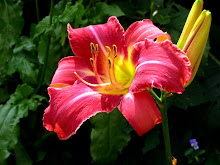Wednesday, September 14, 2011
A-maize-ing Corn
Did you plant sweet corn this year? Here in the Shire, weather conditions were better than usual this summer, and our corn has been the best we’ve ever seen. Long before my vegetable garden grew to such proportions, I kept hearing how difficult it was to grow corn organically; tales of corn borers, having to inject oil into the tip of each ear at particular times, the sorts of things that kept me from growing it at all. No thanks, I thought.
This is perhaps the fifth or sixth year that we’ve grown corn now, and I have to say that it’s been much easier than I previously was led to believe. The first year we were overly ambitious: four types of sweet corn and a large stand of flint corn, sown in a field that had been grass and weeds just the year before … the weeding was a challenge to keep up with. Nonetheless, we had a decent crop, enough to eventually grow tired of eating it on the cob and to put up plenty in the freezer.
This year I grew a variety called “Luscious,” from Fedco, and indeed it has been living up to its name. More realistic now in my planting, this was the smallest patch ever, easier to keep up with -- 10 rows with about 12 cornstalks in each. Lots of fresh eating and lots more for the freezer! Each of these stalks produces two large, full ears of delicious sweet corn (which, even with my primitive math skills, comes to more than 200 ears). And so far (knock on wood) we’ve not been troubled by borers.
Here’s what we’ve found works well for us:
1. Corn is a “heavy feeder,” so it needs to be sown in rich soil. Add plenty of compost first, or grow a cover crop the year before and till it in. Fertilize twice during its growing season – once when the shoots are 4-6” high, again when it’s knee-high or above – using a good organic fertilizer (this year I used North Country Organics ProGro 5-3-4, and couldn’t have been more pleased with the results).
2. Water regularly, if rainfall doesn’t oblige. We use irrigation tape, but soaker hoses or sprinklers work just fine too.
3.And weed! Having a smaller patch this year made it possible to keep up with the weeding. Fewer weeds = more nutrients and moisture available for the corn = better yields.
4. Rotate your crops – do not plant corn where it grew last year. That’s good practice in general for all vegetable growing.
5. Plant enough corn to insure proper pollination ... no fewer than 4 rows. If you end up with more than you can eat, your friends and relatives will be happy to take the surplus off your hands.
6. Plant your corn in a sunny spot! A semi-shaded garden will not serve corn well.
Up until now, all GMO corn has been the field type, grown for cattle feed, ethanol, high-fructose corn syrup, corn chips, and the like. Monsanto is now introducing GMO sweet corn, starting this fall. This is a great time to start growing your own organic corn, if you haven’t been doing it already. You’ve heard those stories about having the water boiling before you pick the ears, and getting them into the pot as fast as possible for the best flavor? It’s true! Try it!
Subscribe to:
Post Comments (Atom)



No comments:
Post a Comment